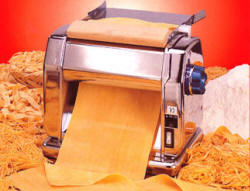|
Your online resource for all things culinary |
|
|||||||||
|
||||||||||
|
||||||||||
| Â | ||||||||||
|
||||||||||
|
Electric or Manual The main difference is the fact that you have two hands free to guide the dough through the rollers. Once again, electric versions are much more expensive, though easier to handle.  Additional features and attachments Some machines have additional attachments through which the dough is passed to cut the pasta to the appropriate size of pasta. Look for a model which has 6 or more discs allowing you to make a wide variety of shapes e.g. thin spaghetti, regular spaghetti, linguine, fettuccine, macaroni and ravioli. Also, look for a model which has a countertop clamp which will stabilise the machine whilst it's being used.
Construction material If possible,
choose stainless steel machines rather than chrome plated steel as they
are easier to clean and won�t rust. Standard Safety Marks, Warranties, Manual   Look for a pasta machine with a recognised safety mark for your particular country (particularly for electric machines) which is a sign that the manufacturer follows the best safety precautions and for a model with at least a 1 year warranty.  Good Reviews  Check cooking magazines and websites to read reviews from other consumers and businesses.   How much should you spend? Although prices range from relatively cheap to very expensive, always be guided by what you think you will need based on the above criteria, rather than on price. If you are unsure, it's best to pay a little extra and get more functions. Currently (as at 2008) prices range from as little as �15 for a very basic roller to +�000s for a fully automated electric pasta maker.  |
||||||||||
Â
|
||||||||||
| Â | ||||||||||

